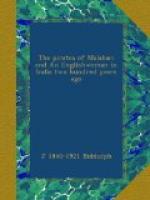In October, 1730, intelligence having been received of Angrian gallivats cruising north of Bombay, some Bombay gallivats were sent out, and after a smart action captured three of them, each carrying five guns. A month later, the Bombay and Bengal galleys were attacked off Colaba by four grabs and fifteen gallivats. There was a calm at the time: the hostile grabs were towed under the galleys’ stern and opened a heavy fire. The galleys were only able to reply with small arm fire, and suffered severely. Several attempts to board were repelled, when an unlucky shot exploded two barrels of musket cartridges on board the Bengal. The quarter-deck was blown up, and, in the confusion, the enemy boarded and carried the ship. The first lieutenant, although wounded, jumped overboard and swam to the Bombay, which was also in evil plight. A similar explosion had occurred, killing the captain, the first lieutenant, and many of the crew. At this juncture came a welcome breeze, bringing up the Victory grab, which had witnessed the fight without being able to take part in it, and the Angrians drew off. No less than eighty Europeans were lost to the Company in this action.
In January, 1732, the Ockham, East Indiaman, coming up the coast with a light wind, was beset, off Dabul, by an Angrian squadron of five grabs and three gallivats. At sunset they came within shot, and a little harmless cannonading took place at long range, till dark. At one in the morning, the moon having risen, they bore down again and attacked the Ockham in their favourite manner, astern. For some time the East Indiaman was exposed to the fire of ten nine-pounders, to which it could only reply with two stern-chasers. Captain Jobson, finding his rigging much cut up, and seeing that the loss of a mast would probably entail the loss of his ship, determined to entice them to close quarters, in the good breeze that was springing up. The plan was explained to the crew, who were in good heart, and encouraged by a promise of two months’ pay. Every gun was manned, while the fire of the two stern-chasers was allowed to slacken, as if ammunition was running short. The bait took; the grabs drew up on the Ockham’s quarter, with their crews cheering and sounding trumpets. At a cable’s distance the Ockham suddenly tacked; and as she gathered way on her new course, she was in the midst of the grabs, firing into them round shot and grape, together with volleys of small arms. This unexpected manoeuvre made the Angrians draw off, and the Ockham resumed her course. At daybreak, only four grabs were in chase, the fifth having evidently suffered severe injuries. A stiff breeze had sprung up, and the crew were eager for another bout, so the Ockham tacked again, and stood for the grabs. But they had had enough of it, and evaded coming to close quarters. Their best chances of successes lay in calms and light airs. With an antagonist like Jobson, in a good stiff wind, the odds were against them; they had lost many men; so after hovering round for some hours they made off to Severndroog.




